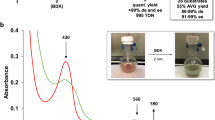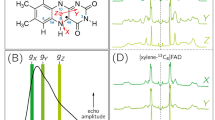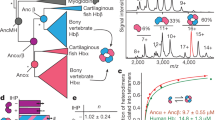Abstract
Haem is degraded to bile pigments in the catabolism of haemoproteins in mammals1 and in the formation of photosynthetic pigments in algae2. The first stage of this reaction involves oxygen attack at one of the four methene-bridge carbon atoms, which is ultimately eliminated as CO(ref. 1). The four bridges are not sterically equivalent (Fig. 1) and the bilirubin in mammalian bile and algal bile pigments consists almost exclusively of the α-isomers. Little is known about the structures of the ring-cleaving enzymes responsible, although microsomal haem oxygenase, which catalyses the breakdown of haem to biliverdin in mammals1, has very similar spectroscopic properties to myo-globin3. The degradation process has been simulated in vitro by a ‘coupled oxidation’ method in which the proportions of the four possible isomeric products depend on the nature of the globin moiety to which the haem is bound4. We report here the use of an interactive computer display system5 to explore the relative accessibilities of the four methene bridges to a haem-bound oxygen molecule in myoglobin and in the α and β chains of haemoglobin. Our calculated interaction energies agree well with the proportions of the four isomers that are observed experimentally.
This is a preview of subscription content, access via your institution
Access options
Subscribe to this journal
Receive 51 print issues and online access
$199.00 per year
only $3.90 per issue
Buy this article
- Purchase on Springer Link
- Instant access to full article PDF
Prices may be subject to local taxes which are calculated during checkout
Similar content being viewed by others
References
Schmid, R. & McDonagh, A. F. Ann. N.Y. Acad. Set. 244, 533–552 (1975).
Troxler, R. F. & Bogorad, L. PL Physiol. 41, 491–499 (1966).
Yoshida, T. & Kikuchi, G. J. biol Chem. 254, 4487–4491 (1979).
O'Carra, P. in Porphyrins and Metalloporphyrins (ed. Smith, K. M.) 123–153 (Elsevier, Amsterdam, 1975).
North, A. C. T., Denson, A. K., Evans, A. C., Ford, L .O. & Willoughby, T. V. in Biomolecular Structure, Conformation, Function and Evolution Vol. 1 (ed. Srinivasan, R.) 59–72 (Pergamon, Oxford, 1980).
Brown, S. B. & King, R. F. G. J. Biochem. J. 170, 299–311 (1978).
Troxler, R. F., Brown, A. S. & Brown, S. B. J. biol, Chem. 254, 3411–3418 (1979).
King, R. F. G. J. & Brown, S. B. Biochem. J. 174, 103–109 (1978).
Chancy, B. D. & Brown, S. B. Biochem. Soc. Trans. 6, 419–421 (1978).
Ladner, R. C., Heidner, E. G. & Perutz, M. F. J. molec. Biol. 114, 385–414 (1977).
Kendrew, J. C. & Watson, H. C. Prog. Stereochem. 4, 299–333 (1969).
Brown, S. B. Biochem. J. 159, 23–27 (1976).
Scott, R. A. & Scheraga, H. A. J. chem. Phys. 45, 2091–2101 (1966).
Bernstein, F. C. et al. J. molec. Biol. 112 535–542 (1977).
Phillips, S. E. V. Nature 273, 247–248 (1978).
Docherty, J. C. thesis, Univ. Leeds (1980).
Brown, S. B. & Docherty, J. C. Biochem. J. 173, 985–987 (1978).
Lehtovaara, P. & Perttila, U. Biochem. J. 176, 359–364 (1978).
Author information
Authors and Affiliations
Rights and permissions
About this article
Cite this article
Brown, S., Chabot, A., Enderby, E. et al. Orientation of oxygen in oxyhaemoproteins and its implications for haem catabolism. Nature 289, 93–95 (1981). https://doi.org/10.1038/289093a0
Received:
Accepted:
Issue Date:
DOI: https://doi.org/10.1038/289093a0
This article is cited by
-
eUnaG: a new ligand-inducible fluorescent reporter to detect drug transporter activity in live cells
Scientific Reports (2017)
-
Solution 1H NMR study of the accommodation of the side chain of n-butyl-etiohemin-I incorporated into the active site of cyano-metmyoglobin
JBIC Journal of Biological Inorganic Chemistry (2005)
Comments
By submitting a comment you agree to abide by our Terms and Community Guidelines. If you find something abusive or that does not comply with our terms or guidelines please flag it as inappropriate.



